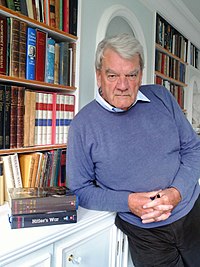1978 ⟶ Willis Carto Founds the Institute for Historical Review
In 1978 Willis Carto founded the Institute for Historical Re...Year
1974
1976
1977
1978
1980
✍️ Publication of 'Did Six Million Really Die?'
Did Six Million Really Die?? The Truth at Last is a Holocaust denial pamphlet allegedly written by British National Front member Richard Verrall under the pseudonym Richard E. Harwood and published by Ernst Zündel in 1974.⟶

Holocaust DenialAnti-SemitismRevisionismErnst ZündelRichard Verrall1970sPropaganda
 United Kingdom
United Kingdom🤥 Publication of 'The Hoax of the Twentieth Century'
Arthur Butz's The Hoax of the Twentieth Century: The case against the presumed extermination of European Jewry was published.⟶

Holocaust DenialArthur ButzAnti-SemitismRevisionism1970sAcademic FraudThe Hoax of the Twentieth Century
 United States
United States📖 Publication of David Irving's 'Hitler's War'
David Irving's Holocaust denying book Hitler's War was published.⟶

Holocaust DenialDavid IrvingHitler1970sRevisionismWorld War IIAnti-Semitism
 United Kingdom
United Kingdom🏢 Willis Carto Founds the Institute for Historical Review
In 1978 Willis Carto founded the Institute for Historical Review (IHR), an organization dedicated to publicly challenging the commonly accepted history of the Holocaust.⟶

Holocaust DenialInstitute for Historical ReviewWillis CartoRevisionism1970sPropagandaAnti-Semitism
 United States
United States✍️ Robert Faurisson's Holocaust Denial Letters
In December 1978 and January 1979, Robert Faurisson, a French professor of literature at the University of Lyon, wrote two letters to Le Monde claiming that the Gas chambers used by the Nazis to exterminate the Jews did not exist.⟶

Holocaust DenialHistorical RevisionismAnti-SemitismIntellectual DiscoursePropagandaAcademic ControversyPost-WarFaurissonGas Chambers
 France
France💰 Institute for Historical Review's Auschwitz Reward Challenge and Lawsuit
In 1980, the Institute for Historical Review promised a $50,000 reward to anyone who could prove that Jews were gassed at Auschwitz. Mel Mermelstein wrote a letter to the editors of the LA Times and others including The Jerusalem Post. The IHR wrote back, offering him $50,000 for proof that Jews were, in fact, gassed in the gas chambers at Auschwitz. Mermelstein, in turn, submitted a notarized account of his internment at Auschwitz and how he witnessed Nazi guards ushering his mother and two sisters and others towards (as he learned later) gas chamber number five. Despite this, the IHR refused to pay the reward. Represented by public interest attorney William John Cox, Mermelstein subsequently sued the IHR in the Superior Court of Los Angeles Countyℳ for Breach of contract, Anticipatory repudiation, Libel, Injurious denial of established fact, Intentional infliction of emotional distress, and Declaratory relief (see case no. C 356 542). On 9 October 1981, both parties in the Mermelstein case filed motions for Summary judgment in consideration of which Judge Thomas T. Johnson of the Superior Court of Los Angeles County took "Judicial notice of the fact that Jews were gassed to death at the Auschwitz Concentration Camp in Poland during the summer of 1944," Judicial notice meaning that the court treated the gas chambers as common knowledge, and therefore did not require evidence that the gas chambers existed. On 5 August 1985, Judge Robert A. Wenke entered a judgment based upon the Stipulation for Entry of Judgment agreed upon by the parties on 22 July 1985. The judgment required IHR and other defendants to pay $90,000 to Mermelstein and to issue a letter of apology to "Mr. Mel Mermelstein, a survivor of Auschwitz-Birkenau and Buchenwald, and all other survivors of Auschwitz" for "pain, anguish and suffering" caused to them.⟶

Holocaust DenialInstitute for Historical ReviewMel MermelsteinAuschwitzLegal BattleHolocaustGas ChambersHistorical Revisionism
 United States
United States Poland
Poland